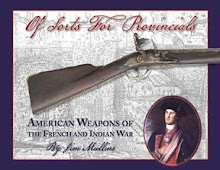A frequent topic amongst those obsessed with backcountry history is the availability or lack thereof of European manufactured material goods. A lot of 19th and quite a few 20th century authors placed a heavy emphasis on the romantic image of the stalwart frontiersman (and woman) in buckskin clothing head to toe, weaving coarse linsey woolsey by their fires at night and producing all of their family's necessaries (I assume folks could weave, farm and hunt much more rapidly in the 18thc century as those are time consuming ventures!). Although in some cases families did weave and produce limited amounts of textiles for their own consumption and at times barter or sale, taking a hard look at probate inventories, store accounts and primary documents quickly deflates the notion that frontier Americans were not a part of the global economy and consumers of large quantities of imported goods (even those engaged in the deer skin trade or those living in far flung areas).
One of my favorite recent books on the subject is a discussion of John Hook's store in New London (Bedford) Virginia is Martin's Buying into the World of Goods. http://books.google.com/books?id=J0P6rmhhP6IC&printsec=frontcover&dq=buying+into+the+world+of+goods+martin&hl=en&ei=vy3xTZiyLNS_gQee8uWzBA&sa=X&oi=book_result&ct=result&resnum=1&ved=0CCoQ6AEwAA#v=onepage&q&f=false Although many Virginia stores in the back country trafficked heavily in rum and coarse osnaburg linen many also carried items that were purely luxury goods. Conway Smith's Book The Land That Is Pulaski County features a lengthy description of the goods available ca. 1774-1777 at McCorkle's store in New Dublin Virginia.
Original swatch of "Striped Camblet" from the Foundling Museum's Threads of feeling Exhibit
Fabrics:
colored baize, silk ferret, gingham, muslin,
frieze, cambleteen, white and green Persian, tammy cloth, silk cloth, "oznabrig", Irish linen, holland, stroud; cambric, calico, queens net, "forrest" cloth, flowered lawn, dimity, broadcloth, callimanco, flannel, blue and green "durant", shalloon, buckram, gauze, permentum, brown and white sheeting, plush "for making shot pouches", apron lawn, saddle cloth, cloth for "leggons" (leggings), coating material, fringed housing, deer skins and otter skins. There were also white and colored threads, needles, thimbles, scissors, papers of pins, a variety of buttons, hanks of silk, tapes, ribbons, lace-and for dyeing cloth, indigo and copperas.
As far as clothing and accessories:
[locally manufactured] raccoon hats, felt hats, gloves, fine and plain shoes, coat strops, shirts, stocking breeches, stockings, garters, shoe buckles, shoe brushes, razors, pocket looking glasses, and watch chains. For the ladies there were silk bonnets, calico gowns, stockings, garters, necklaces, fans, silk gauze handkerchiefs, linen and spotted lawn handkerchiefs, printed and check handkerchiefs, shoes, gloves ,looking glasses...hunting shirts ,leggings,children's shoes and hats.
Hardware included:
pewter tableware, queen china plates, knives and forks, pewter spoons, toddy ladles, toddy spoons, teaspoons, teakettles, brass kettles, skillets, iron pots, brass pots, tin pans, tin kettles, frying pans, butcher .knives, irons, combs and brushes, rugs, trunks, Dutch blankets, pewter candle molds and candle snuffers, guns, gun flints, lead, powder, shot, shot pouches, knives, lead bars, pig iron, chest locks, cupboard locks, padlocks, grindstones, shears, reaping hooks, carpenter's rules, carpenter's compasses, claw hammers, hinges, nails, screws, cuttoes, drawing knives, handsaws, whipsaws, rasps, files, chisels, gimlets, rope, catgut, scales, money weights, salt bags, sacking, alum, soap, tallow, hemp, Dutch quills, penknives, inkholders, ink powder, paper by the quire and sealing wax....
Foodstuffs included:
Venison hams, salt, pepper, white and brown sugar, butter, allspice, nutmegs, coffee, rum, tea and chocolate.
Smith concludes:
"The year of 1774 found settlers in the land that is now Pulaski County living better than we had imagined."
Similar goods were available in the Matthews store (both available by contacting the Greenbrier Historical Society):
The Mathews Trading Post", published in The Journal of the Greenbrier Historical Society: Volume 1, Number 1 (Lewisburg, West Virginia: Greenbrier Historical Society, August 1963).
Frances Alderson Swope, comp., "The Matthews Trading Post Ledger, 1771-1779,"
Journal of the Greenbrier Historical Society 4 (1984), 20.
Happy shopping and research!


